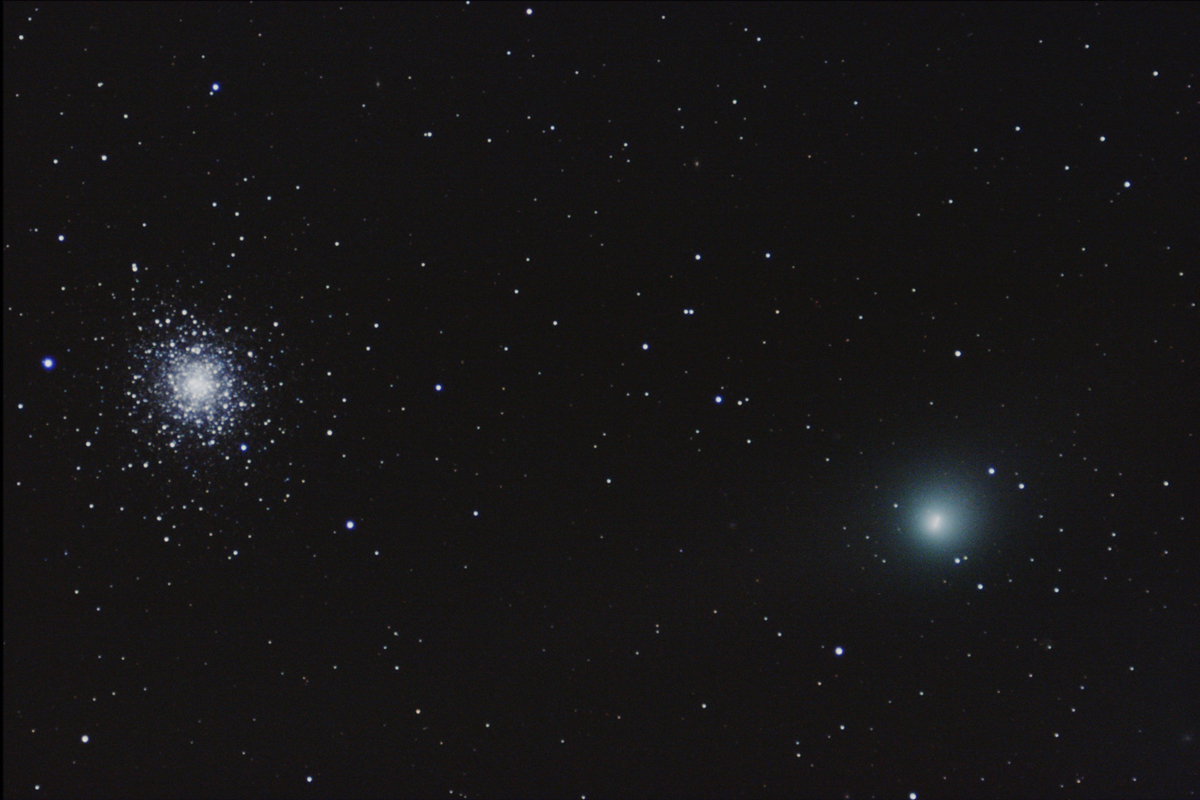Dazzling Comet Garradd Has Close Encounter with Star Cluster

A comet and a sparkly star cluster shined bright together this month in a space rendezvous captured by an astronomer in California.
The cosmic close encounter featured the comet Garradd and bright globular star cluster M92. It was photographed by astronomer Conrad Jung with the Chabot Space & Science Center in Oakland, Calif.
Jung used a 5-inch refractor telescope to snap a 10-minute exposure of comet Garradd as it zipped close by M92 on Feb. 3. Both objects were in the constellation Hercules at the time.
Jung's photo of comet Garrad and M92 covers an area of the sky just 1 degree across. Your closed fist held out at arm's length covers about 10 degrees of the night sky.
While comet Garradd and star cluster appeared close to each other, it was only a trick of perspective. Star cluster M92 is actually about 27,000 light-years from Earth, while comet Garradd is currently zipping through our inner solar system. From Earth's vantage point, the two objects were just 0.5 degrees apart in the night sky on Feb. 3.
"Comet Garradd is only a few light minutes away from Earth and travelling very fast," Chabot center officials wrote in a statement. "In the next month, Comet Garradd will be at its closest point to Earth and should be visible with binoculars or a small telescope near the cup of the Big Dipper."
The comet will make its closest approach to Earth in March, when it will fly within 1.3 astronomical units of our planet, according to the skywatching website Spaceweather.com. One astronomical unit is the distance between the Earth and the sun, about 93 million miles (150 million kilometers).
Get the Space.com Newsletter
Breaking space news, the latest updates on rocket launches, skywatching events and more!
Comet Garradd is formally known as comet Garrad (C2009 P1) and was discovered on Aug. 13, 2009 by Australian astronomer G.J. Garradd. In November 2011, the comet provided skywatchers with a dazzling show observers with small telescopes and binoculars.
Editor's note: If you have an amazing skywatching photo you'd like to share for a possible story or image gallery, please contact managing editor Tariq Malik at tmalik@space.com.
You can follow SPACE.com Managing Editor Tariq Malik on Twitter @tariqjmalik. Follow SPACE.com for the latest in space science and exploration news on Twitter @Spacedotcom and on Facebook.
Join our Space Forums to keep talking space on the latest missions, night sky and more! And if you have a news tip, correction or comment, let us know at: community@space.com.

Tariq is the Editor-in-Chief of Space.com and joined the team in 2001, first as an intern and staff writer, and later as an editor. He covers human spaceflight, exploration and space science, as well as skywatching and entertainment. He became Space.com's Managing Editor in 2009 and Editor-in-Chief in 2019. Before joining Space.com, Tariq was a staff reporter for The Los Angeles Times covering education and city beats in La Habra, Fullerton and Huntington Beach. In October 2022, Tariq received the Harry Kolcum Award for excellence in space reporting from the National Space Club Florida Committee. He is also an Eagle Scout (yes, he has the Space Exploration merit badge) and went to Space Camp four times as a kid and a fifth time as an adult. He has journalism degrees from the University of Southern California and New York University. You can find Tariq at Space.com and as the co-host to the This Week In Space podcast with space historian Rod Pyle on the TWiT network. To see his latest project, you can follow Tariq on Twitter @tariqjmalik.









